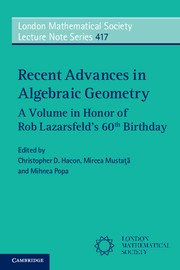Book contents
- Frontmatter
- Contents
- List of contributors
- Preface
- 1 The effect of points fattening in dimension three
- 2 Some remarks on surface moduli and determinants
- 3 Valuation spaces and multiplier ideals on singular varieties
- 4 Line arrangements modeling curves of high degree: Equations, syzygies, and secants
- 5 Rationally connected manifolds and semipositivity of the Ricci curvature
- 6 Subcanonical graded rings which are not Cohen–Macaulay
- 7 Threefold divisorial contractions to singularities of cE type
- 8 Special prime Fano fourfolds of degree 10 and index 2
- 9 Configuration spaces of complex and real spheres
- 10 Twenty points in ℙ3
- 11 The Betti table of a high-degree curve is asymptotically pure
- 12 Partial positivity: Geometry and cohomology of q-ample line bundles
- 13 Generic vanishing fails for singular varieties and in characteristic p > 0
- 14 Deformations of elliptic Calabi–Yau manifolds
- 15 Derived equivalence and non-vanishing loci II
- 16 The automorphism groups of Enriques surfaces covered by symmetric quartic surfaces
- 17 Lower-order asymptotics for Szegö and Toeplitz kernels under Hamiltonian circle actions
- 18 Gaussian maps and generic vanishing I: Subvarieties of abelian varieties
- 19 Torsion points on cohomology support loci: From D-modules to Simpson's theorem
- 20 Rational equivalence of 0-cycles on K3 surfaces and conjectures of Huybrechts and O'Grady
- References
7 - Threefold divisorial contractions to singularities of cE type
Published online by Cambridge University Press: 05 January 2015
- Frontmatter
- Contents
- List of contributors
- Preface
- 1 The effect of points fattening in dimension three
- 2 Some remarks on surface moduli and determinants
- 3 Valuation spaces and multiplier ideals on singular varieties
- 4 Line arrangements modeling curves of high degree: Equations, syzygies, and secants
- 5 Rationally connected manifolds and semipositivity of the Ricci curvature
- 6 Subcanonical graded rings which are not Cohen–Macaulay
- 7 Threefold divisorial contractions to singularities of cE type
- 8 Special prime Fano fourfolds of degree 10 and index 2
- 9 Configuration spaces of complex and real spheres
- 10 Twenty points in ℙ3
- 11 The Betti table of a high-degree curve is asymptotically pure
- 12 Partial positivity: Geometry and cohomology of q-ample line bundles
- 13 Generic vanishing fails for singular varieties and in characteristic p > 0
- 14 Deformations of elliptic Calabi–Yau manifolds
- 15 Derived equivalence and non-vanishing loci II
- 16 The automorphism groups of Enriques surfaces covered by symmetric quartic surfaces
- 17 Lower-order asymptotics for Szegö and Toeplitz kernels under Hamiltonian circle actions
- 18 Gaussian maps and generic vanishing I: Subvarieties of abelian varieties
- 19 Torsion points on cohomology support loci: From D-modules to Simpson's theorem
- 20 Rational equivalence of 0-cycles on K3 surfaces and conjectures of Huybrechts and O'Grady
- References
Summary
Abstract
We survey some recent progress in the classification of three-dimensional divisorial contractions to cE points. In particular, we introduce a new structure of three-dimensional cE singularity and use this structure to explain the work of Hayakawa. We also provide some new examples.
Dedicated to Rob Lazarsfeld on the occasion of his sixtieth birthday
1 Introduction
The minimal model program has been one of the main tools in the study of birational algebraic geometry. After some recent advances in the study of the geometry of complex 3-folds, one might hope to build up an explicit classification theory for 3-folds similar to the theory of surfaces by using the minimal model program.
In the minimal model program, divisorial contractions, flips, and flops are considered to be elementary maps. Any birational map obtained from the minimal model program consists of a combination of the above-mentioned maps. Let us briefly recall some known results about three-dimensional birational maps. First of all, Mori and then Cutkosky classified birational maps from nonsingular 3-folds and Gorenstein 3-folds respectively [4, 20]. Tziolas has produced a series of work on divisorial contractions to curves passing through Gorenstein singularities (cf. [23-25]). The recent project of Mori and Prokhorov (cf. [21, 22]) on extremal contractions provides a treatment which is valid for divisorial contractions to curves and for conic bundles. They classified completely divisorial contractions to curves of type IA, IC, and IIB. Flops are studied in Kollár's article [16]. Flips are still quite mysterious, except for some examples in [2, 18].
Divisorial contractions to points are probably the best understood, due mainly to the works of Kawamata, Hayakawa, Markushevich, and Kawakita (cf. [5-7, 10-15, 19]). Divisorial contractions to points of index > 1 are now completely classified and realized as weighted blow-ups. Therefore, it remains to consider contractions to points of index 1, i.e., terminal Gorenstein singularities. The description of contractions to index 1 points can be found in [13]. In fact, contractions to cA points are classified completely in [13]. Recently, Hayakawa started a project to classify contractions to cD and cE points [8, 9].
- Type
- Chapter
- Information
- Recent Advances in Algebraic GeometryA Volume in Honor of Rob Lazarsfeld’s 60th Birthday, pp. 102 - 122Publisher: Cambridge University PressPrint publication year: 2015
References
- 1
- Cited by



